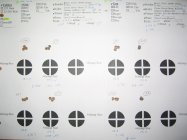Otter said:
Finding the lands and moving in was not as easy as finding jam, so I went the other direction.
Here's something that you should keep in the back of your mind when it comes to the term "JAM". It can mean different things to different people. Use whatever makes sense to YOU. Here are some examples:
-------------------------------------------------------------------
Call me "old school" but to me anytime you are are using the term, "Jam" means bolt closure is seating the bullet by .XXX".
For seating of say 0.020" into the lands, it is just that: seating "into the lands" (ITL) and is not the jam seating.
So if you tell me you are seating your bullets at ITL=.015" I understand you to mean they are engraving the lands by .015".
If you say your at Jam=.015" I understand you to mean the “bolt-closer†is jam-seating the bullet the last .015".
If you say your OTL=.015" I understand you to mean your "off the lands" by .015" with no engraving. ... Donovan Moran
-----------------------------------------------------------
I like what Donavan said. "Jam" is a relative term. Saying ".010 into the lands" seems to be a more accurate description as to what is happening.
In 100-200 yard Benchrest, many of us have found that moving a bullet into the lands, at what first glance would seem like a ridiculous amount, is where many bullets, especially the "double radius" variety, like to shoot.
For instance, I tell shooters that, with the combination I shoot, I "make the marks appear twice as long as they are wide". I really do not know how far into the lands I actually move the bullet to achieve this ... I never measured it. I can feel the bullet lightly "crunch" as the bolt closes.
It is one of the strange quirks that appear when using 133 with this particular style of bullet. ... jackie schmidt
-------------------------------------------------------
Before one can tune a rifle, there must be a starting point. Many use the "JAM" length as a reference to start loading development.
By "JAM" I mean the maximum length that can be obtained ... without the lands pushing the bullet deeper into the case.
Once this is determined, one can tune by moving the bullet only one direction ... deeper into the case. I, like many, have found that many bullets shoot best when seated .008" or .010" off the jam.
After determining a starting point, let the conditions and the results on the targets dictate what tuning is needed.
Joe Krupa, Precision Shooting, August 2008, page 51, under: Where to Start.
------------------------------------------------------------
Jam
One of the things many of us have discovered with the current crop of double radius bullets, when using 133, is that they like to be jammed to the point that you can actually feel the bullet crunch into the lands when you close the bolt.
However, shooters who use these bullets, especially the Bruno BoatTail, with 8208, find that just off the lands to just touching works best.
With a standard .237 4-groove Krieger and 133, I jam the bullets to where the [marks appear to be about twice as long as they are wide.]
These seem tight, but remember, the portion of the bullet that contacts the lands is just about the same shape as the 1.5 degree lead. It really isn't 'tight' in the sense that the bullet is getting compressed more, the marks just sort of skim along the ogive.
Other shooters use different methods with these bullets and 133, but this is where the best agging capability seems to be. ... jackie schmidt
----------------------------------------------------------------------
The point where a bullet touches the origin of the rifling, a point on the angled part of the rifling where it begins at the front of the chamber, is determined without neck tension. There are several methods. I have a gauge that Sinclair sells that requires a fired case, a bullet, and uses an adapter that fits in the rear action bridge of a bolt action, and which works in conjunction with a rod and a couple of stop collars.
In the correct use of the word, which has been widely misused, jam is the maximum length that a bullet may be loaded to, without being pushed back as the round is chambered. It depends on neck tension (difference between sized and loaded neck diameter), interior neck and bullet coefficients of friction, thickness of the neck, and the length of a bullet's engagement in the case neck.
Jump is the amount that a bullet is seated short of touch, which is the same as out of the lands. Into the rifling or longer than touch means exactly the latter.
The shape of a particular bullet's ogive and the throat or leade angle of the barrel determine how many thousandths there are between touch and jam.
When one says that a bullet is seated so many thousandths off of jam, he may still be longer than touch, or not (because of the distance between jam and touch). ..... Boyd Allen
-----------------------------------------------------











